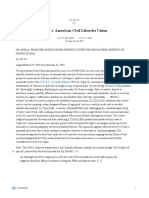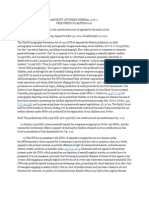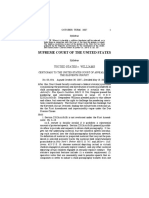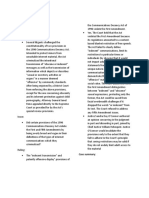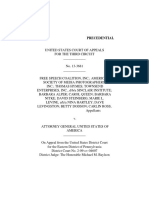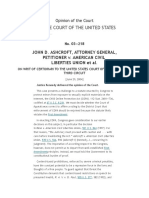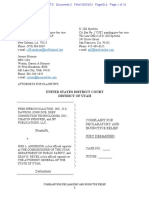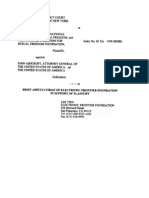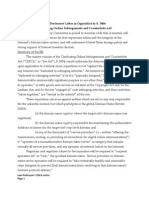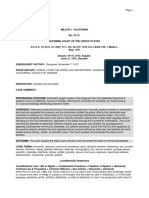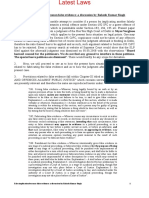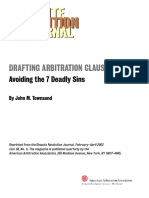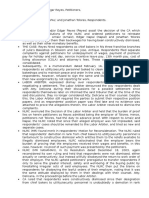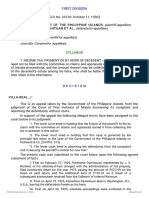SUPREME COURT DECISION IN RENO V ACLU, ET AL
provisions. The court's judgment enjoins the Government from
enforcing 223(a)(1)(B)'s prohibitions insofar as they relate to
SUPREME COURT OF THE UNITED STATES
Syllabus
RENO, ATTORNEY GENERAL OF THE UNITED STATES, et
"indecent" communications, but expressly preserves the
Government's right to investigate and prosecute the obscenity or
child pornography activities prohibited therein. The injunction
al. v. AMERICAN CIVIL LIBERTIES UNION et al.
against enforcement of 223(d) is unqualified because that section
appeal from the united states district court for the eastern district
contains no separate reference to obscenity or child pornography.
of pennsylvania
No. 96-511. Argued March 19, 1997-Decided June 26, 1997
The Government appealed to this Court under the Act's special
review provisions, arguing that the District Court erred in holding
Two provisions of the Communications Decency Act of 1996 (CDA
that the CDA violated both the First Amendment because it is
or Act) seek to protect minors from harmful material on the
overbroad and the Fifth Amendment because it is vague.
Internet, an international network of interconnected computers
Held: The CDA's "indecent transmission" and "patently offensive
that enables millions of people to communicate with one another in
display" provisions abridge "the freedom of speech" protected by
"cyberspace" and to access vast amounts of information from
the First Amendment. Pp. 17-40.
around the world. Title 47 U. S. C. A. 223(a)(1)(B)(ii) (Supp. 1997)
(a) Although the CDA's vagueness is relevant to the First
criminalizes the "knowing" transmission of "obscene or indecent"
Amendment overbreadth inquiry, the judgment should be affirmed
messages to any recipient under 18 years of age. Section 223(d)
without reaching the Fifth Amendment issue. P. 17.
prohibits the "knowin[g]" sending or displaying to a person under
(b) A close look at the precedents relied on by the Government-
18 of any message "that, in context, depicts or describes, in terms
Ginsberg v. New York, 390 U. S. 629; FCC v. Pacifica Foundation,
patently offensive as measured by contemporary community
438 U. S. 726; and Renton v. Playtime Theatres, Inc., 475 U. S. 41-
standards, sexual or excretory activities or organs." Affirmative
raises, rather than relieves, doubts about the CDA's
defenses are provided for those who take "good faith, . . .
constitutionality. The CDA differs from the various laws and orders
effective . . . actions" to restrict access by minors to the prohibited
upheld in those cases in many ways, including that it does not
communications, 223(e)(5)(A), and those who restrict such access
allow parents to consent to their children's use of restricted
by requiring certain designated forms of age proof, such as a
materials; is not limited to commercial transactions; fails to
verified credit card or an adult identification number, 223(e)(5)(B).
provide any definition of "indecent" and omits any requirement
A number of plaintiffs filed suit challenging the constitutionality of
that "patently offensive" material lack socially redeeming value;
223(a)(1) and 223(d). After making extensive findings of fact, a
neither limits its broad categorical prohibitions to particular times
three-judge District Court convened pursuant to the Act entered a
nor bases them on an evaluation by an agency familiar with the
preliminary injunction against enforcement of both challenged
medium's unique characteristics; is punitive; applies to a medium
�that, unlike radio, receives full First Amendment protection; and
set forth in Miller v. California, 413 U. S. 15, 24. The second Miller
cannot be properly analyzed as a form of time, place, and manner
prong reduces the inherent vagueness of its own "patently
regulation because it is a content-based blanket restriction on
offensive" term by requiring that the proscribed material be
speech. These precedents, then, do not require the Court to uphold
"specifically defined by the applicable state law." In addition, the
the CDA and are fully consistent with the application of the most
CDA applies only to "sexual conduct," whereas, the CDA
stringent review of its provisions. Pp. 17-21.
prohibition extends also to "excretory activities" and "organs" of
(c) The special factors recognized in some of the Court's cases as
both a sexual and excretory nature. Each of Miller's other two
justifying regulation of the broadcast media-the history of
prongs also critically limits the uncertain sweep of the obscenity
extensive government regulation of broadcasting, see, e.g., Red
definition. Just because a definition including three limitations is
Lion Broadcasting Co. v. FCC, 395 U. S. 367, 399-400; the scarcity
not vague, it does not follow that one of those limitations, standing
of available frequencies at its inception, see, e.g., Turner
alone, is not vague. The CDA's vagueness undermines the
Broadcasting System, Inc. v. FCC, 512 U. S. 622, 637-638; and its
likelihood that it has been carefully tailored to the congressional
"invasive" nature, see Sable Communications of Cal., Inc. v. FCC,
goal of protecting minors from potentially harmful materials. Pp.
492 U. S. 115, 128-are not present in cyberspace. Thus, these
24-28.
cases provide no basis for qualifying the level of First Amendment
(e) The CDA lacks the precision that the First Amendment requires
scrutiny that should be applied to the Internet. Pp. 22-24.
when a statute regulates the content of speech. Although the
(d) Regardless of whether the CDA is so vague that it violates the
Government has an interest in protecting children from potentially
Fifth Amendment, the many ambiguities concerning the scope of
harmful materials, see, e.g., Ginsberg, 390 U. S., at 639, the CDA
its coverage render it problematic for First Amendment purposes.
pursues that interest by suppressing a large amount of speech that
For instance, its use of the undefined terms "indecent" and
adults have a constitutional right to send and receive, see, e.g.,
"patently offensive" will provoke uncertainty among speakers
Sable, supra, at 126. Its breadth is wholly unprecedented. The
about how the two standards relate to each other and just what
CDA's burden on adult speech is unacceptable if less restrictive
they mean. The vagueness of such a content-based regulation,
alternatives would be at least as effective in achieving the Act's
see, e.g., Gentile v. State Bar of Nev., 501 U. S. 1030, coupled with
legitimate purposes. See, e.g., Sable, 492 U. S., at 126. The
its increased deterrent effect as a criminal statute, see, e.g.,
Government has not proved otherwise. On the other hand, the
Dombrowski v. Pfister, 380 U. S. 479, raise special First
District Court found that currently available user-based software
Amendment concerns because of its obvious chilling effect on free
suggests that a reasonably effective method by which parents can
speech. Contrary to the Government's argument, the CDA is not
prevent their children from accessing material which the parents
saved from vagueness by the fact that its "patently offensive"
believe is inappropriate will soon be widely available. Moreover,
standard repeats the second part of the three-prong obscenity test
the arguments in this Court referred to possible alternatives such
�as requiring that indecent material be "tagged" to facilitate
indicate their contents, thus permitting recipients to block their
parental control, making exceptions for messages with artistic or
reception with appropriate software, is illusory, given the
educational value, providing some tolerance for parental choice,
requirement that such action be "effective": The proposed
and regulating some portions of the Internet differently than
screening software does not currently exist, but, even if it did,
others. Particularly in the light of the absence of any detailed
there would be no way of knowing whether a potential recipient
congressional findings, or even hearings addressing the CDA's
would actually block the encoded material. The Government also
special problems, the Court is persuaded that the CDA is not
failed to prove that 223(b)(5)'s verification defense would
narrowly tailored. Pp. 28-33.
significantly reduce the CDA's heavy burden on adult speech.
(f) The Government's three additional arguments for sustaining the
Although such verification is actually being used by some
CDA's affirmative prohibitions are rejected. First, the contention
commercial providers of sexually explicit material, the District
that the Act is constitutional because it leaves open ample
Court's findings indicate that it is not economically feasible for
"alternative channels" of communication is unpersuasive because
most noncommercial speakers. Pp. 35-37.
the CDA regulates speech on the basis of its content, so that a
(h) The Government's argument that this Court should preserve
"time, place, and manner" analysis is inapplicable. See, e.g.,
the CDA's constitutionality by honoring its severability clause,
Consolidated Edison Co. of N. Y. v. Public Serv. Comm'n of N.
608, and by construing nonseverable terms narrowly, is
Y., 447 U. S. 530, 536. Second, the assertion that the CDA's
acceptable in only one respect. Because obscene speech may be
"knowledge" and "specific person" requirements significantly
banned totally, see Miller, supra, at 18, and 223(a)'s restriction of
restrict its permissible application to communications to persons
"obscene" material enjoys a textual manifestation separate from
the sender knows to be under 18 is untenable, given that most
that for "indecent" material, the Court can sever the term "or
Internet forums are open to all comers and that even the strongest
indecent" from the statute, leaving the rest of 223(a) standing.
reading of the "specific person" requirement would confer broad
Pp. 37-39.
powers of censorship, in the form of a "heckler's veto," upon any
(i) The Government's argument that its "significant" interest in
opponent of indecent speech. Finally, there is no textual support
fostering the Internet's growth provides an independent basis for
for the submission that material having scientific, educational, or
upholding the CDA's constitutionality is singularly unpersuasive.
other redeeming social value will necessarily fall outside the CDA's
The dramatic expansion of this new forum contradicts the factual
prohibitions. Pp. 33-35.
basis underlying this contention: that the unregulated availability
(g) The 223(e)(5) defenses do not constitute the sort of "narrow
of "indecent" and "patently offensive" material is driving people
tailoring" that would save the CDA. The Government's argument
away from the Internet. P. 40.
that transmitters may take protective "good faith actio[n]" by
929 F. Supp. 824, affirmed.
"tagging" their indecent communications in a way that would
Stevens, J., delivered the opinion of the Court, in which Scalia,
�Kennedy, Souter, Thomas, Ginsburg, and Breyer, JJ., joined.
of
O'Connor, J., filed an opinion concurring in the judgment in part
sexually explicit material in that medium, and the problems
and dissenting in part, in which Rehnquist, C. J., joined.
confronting age verification for recipients of Internet
NOTICE: This opinion is subject to formal revision before
communications. Because those findings provide the
publication in the preliminary print of the United States Reports.
underpinnings for the legal issues, we begin with a summary of the
Readers are requested to notify the Reporter of Decisions, Supreme
undisputed facts.
Court of the United States, Wash-ington, D.C. 20543, of any
The Internet
typographical or other formal errors, in order that corrections may
The Internet is an international network of interconnected
be made before the preliminary print goes to press.
computers. It is the outgrowth of what began in 1969 as a military
program called "ARPANET,"(3) which was designed to enable
SUPREME COURT OF THE UNITED STATES
computers operated by the military, defense contractors, and
No. 96-511
universities conducting defense-related research to communicate
JANET RENO, ATTORNEY GENERAL OF THE UNITED STATES, et al.,
with one another by redundant channels even if some portions of
APPELLANTS v. AMERICAN CIVIL LIBERTIES UNION et al.
the network were damaged in a war. While the ARPANET no longer
on appeal from the united states district court for the eastern
exists, it provided an example for the development of a number of
district of pennsylvania
[June 26, 1997]
civilian networks that, eventually linking with each other, now
enable tens of millions of people to communicate with one another
Justice Stevens delivered the opinion of the Court.
and to access vast amounts of information from around the world.
At issue is the constitutionality of two statutory provisions enacted
The Internet is "a unique and wholly new medium of worldwide
to protect minors from "indecent" and "patently offensive"
human communication."(4)
communications on the Internet. Notwithstanding the legitimacy
The Internet has experienced "extraordinary growth."(5) The
and importance of the congressional goal of protecting children
number of "host" computers-those that store information and relay
from harmful materials, we agree with the three-judge District
communications-increased from about 300 in 1981 to
Court that the statute abridges "the freedom of speech" protected
approximately 9,400,000 by the time of the trial in 1996. Roughly
by the First Amendment.(1)
60% of these hosts are located in the United States. About 40
million people used the Internet at the time of trial, a number that
The District Court made extensive findings of fact, most of which
is expected to mushroom to 200 million by 1999.
were based on a detailed stipulation prepared by the parties. See
Individuals can obtain access to the Internet from many different
929 F. Supp. 824, 830-849 (ED Pa. 1996).(2) The findings describe
sources, generally hosts themselves or entities with a host
the character and the dimensions of the Internet, the availability
affiliation. Most colleges and universities provide access for their
�students and faculty; many corporations provide their employees
message to the group's other subscribers. Newsgroups also serve
with access through an office network; many communities and
groups of regular participants, but these postings may be read by
local libraries provide free access; and an increasing number of
others as well. There are thousands of such groups, each serving to
storefront "computer coffee shops" provide access for a small
foster an exchange of information or opinion on a particular topic
hourly fee. Several major national "online services" such as
running the gamut from, say, the music of Wagner to Balkan
America Online, CompuServe, the Microsoft Network, and Prodigy
politics to AIDS prevention to the Chicago Bulls. About 100,000
offer access to their own extensive proprietary networks as well as
new messages are posted every day. In most newsgroups, postings
a link to the much larger resources of the Internet. These
are automatically purged at regular intervals. In addition to posting
commercial online services had almost 12 million individual
a message that can be read later, two or more individuals wishing
subscribers at the time of trial.
to communicate more immediately can enter a chat room to
Anyone with access to the Internet may take advantage of a wide
engage in real-time dialogue-in other words, by typing messages to
variety of communication and information retrieval methods. These
one another that appear almost immediately on the others'
methods are constantly evolving and difficult to categorize
computer screens. The District Court found that at any given time
precisely. But, as presently constituted, those most relevant to this
"tens of thousands of users are engaging in conversations on a
case are electronic mail ("e-mail"), automatic mailing list services
huge range of subjects."(6) It is "no exaggeration to conclude that
("mail exploders," sometimes referred to as "listservs"),
the content on the Internet is as diverse as human thought."(7)
"newsgroups," "chat rooms," and the "World Wide Web." All of
The best known category of communication over the Internet is the
these methods can be used to transmit text; most can transmit
World Wide Web, which allows users to search for and retrieve
sound, pictures, and moving video images. Taken together, these
information stored in remote computers, as well as, in some cases,
tools constitute a unique medium-known to its users as
to communicate back to designated sites. In concrete terms, the
"cyberspace"-located in no particular geographical location but
Web consists of a vast number of documents stored in different
available to anyone, anywhere in the world, with access to the
computers all over the world. Some of these documents are simply
Internet.
files containing information. However, more elaborate documents,
E-mail enables an individual to send an electronic message-
commonly known as Web "pages," are also prevalent. Each has its
generally akin to a note or letter-to another individual or to a group
own address-"rather like a telephone number."(8) Web pages
of addressees. The message is generally stored electronically,
frequently contain information and sometimes allow the viewer to
sometimes waiting for the recipient to check her "mailbox" and
communicate with the page's (or "site's") author. They generally
sometimes making its receipt known through some type of prompt.
also contain "links" to other documents created by that site's
A mail exploder is a sort of e-mail group. Subscribers can send
author or to other (generally) related sites. Typically, the links are
messages to a common e-mail address, which then forwards the
either blue or underlined text-sometimes images.
�Navigating the Web is relatively straightforward. A user may either
manner as material that is not sexually explicit, and may be
type the address of a known page or enter one or more keywords
accessed either deliberately or unintentionally during the course of
into a commercial "search engine" in an effort to locate sites on a
an imprecise search. "Once a provider posts its content on the
subject of interest. A particular Web page may contain the
Internet, it cannot prevent that content from entering any
information sought by the "surfer," or, through its links, it may be
community."(12) Thus, for example, "when the UCR/California
an avenue to other documents located anywhere on the Internet.
Museum of Photography posts to its Web site nudes by Edward
Users generally explore a given Web page, or move to another, by
Weston and Robert Mapplethorpe to announce that its new exhibit
clicking a computer "mouse" on one of the page's icons or links.
will travel to Baltimore and New York City, those images are
Access to most Web pages is freely available, but some allow
available not only in Los Angeles, Baltimore, and New York City, but
access only to those who have purchased the right from a
also in Cincinnati, Mobile, or Beijing-wherever Internet users live.
commercial provider. The Web is thus comparable, from the
Similarly, the safer sex instructions that Critical Path posts to its
readers' viewpoint, to both a vast library including millions of
Web site, written in street language so that the teenage receiver
readily available and indexed publications and a sprawling mall
can understand them, are available not just in Philadelphia, but
offering goods and services.
also in Provo and Prague."(13)
From the publishers' point of view, it constitutes a vast platform
Some of the communications over the Internet that originate in
from which to address and hear from a world-wide audience of
foreign countries are also sexually explicit.(14)
millions of readers, viewers, researchers, and buyers. Any person
Though such material is widely available, users seldom encounter
or organization with a computer connected to the Internet can
such content accidentally. "A document's title or a description of
"publish" information. Publishers include government agencies,
the document will usually appear before the document itself . . .
educational institutions, commercial entities, advocacy groups, and
and in many cases the user will receive detailed information about
individuals.(9) Publishers may either make their material available
a site's content before he or she need take the step to access the
to the entire pool of Internet users, or confine access to a selected
document. Almost all sexually explicit images are preceded by
group, such as those willing to pay for the privilege. "No single
warnings as to the content."(15) For that reason, the "odds are
organi zation controls any membership in the Web, nor is there any
slim" that a user would enter a sexually explicit site by accident.
centralized point from which individual Web sites or services can
(16) Unlike communications received by radio or television, "the
be blocked from the Web."(10)
receipt of information on the Internet requires a series of
Sexually Explicit Material
affirmative steps more deliberate and directed than merely turning
Sexually explicit material on the Internet includes text, pictures,
a dial. A child requires some sophistication and some ability to read
and chat and "extends from the modestly titillating to the hardest-
to retrieve material and thereby to use the Internet
core."(11) These files are created, named, and posted in the same
unattended."(17)
�Systems have been developed to help parents control the material
verification is only feasible, however, either in connection with a
that may be available on a home computer with Internet access. A
commercial transaction in which the card is used, or by payment to
system may either limit a computer's access to an approved list of
a verification agency. Using credit card possession as a surrogate
sources that have been identified as containing no adult material,
for proof of age would impose costs on non-commercial Web sites
it may block designated inappropriate sites, or it may attempt to
that would require many of them to shut down. For that reason, at
block messages containing identifiable objectionable features.
the time of the trial, credit card verification was "effectively
"Although parental control software currently can screen for certain
unavailable to a substantial number of Internet content providers."
suggestive words or for known sexually explicit sites, it cannot now
Id., at 846 (finding 102). Moreover, the imposition of such a
screen for sexually explicit images."(18) Nevertheless, the
requirement "would completely bar adults who do not have a
evidence indicates that "a reasonably effective method by which
credit card and lack the resources to obtain one from accessing
parents can prevent their children from accessing sexually explicit
any blocked material."(22)
and other material which parents may believe is inappropriate for
Commercial pornographic sites that charge their users for access
their children will soon be available."(19)
have assigned them passwords as a method of age verification.
Age Verification
The record does not contain any evidence concerning the reliability
The problem of age verification differs for different uses of the
of these technologies. Even if passwords are effective for
Internet. The District Court categorically determined that there "is
commercial purveyors of indecent material, the District Court
no effective way to determine the identity or the age of a user who
found that an adult password requirement would impose significant
is accessing material through e-mail, mail exploders, newsgroups
burdens on noncommercial sites, both because they would
or chat rooms."(20) The Government offered no evidence that
discourage users from accessing their sites and because the cost
there was a reliable way to screen recipients and participants in
of creating and maintaining such screening systems would be
such fora for age. Moreover, even if it were technologically feasible
"beyond their reach."(23)
to block minors' access to newsgroups and chat rooms containing
In sum, the District Court found:
discussions of art, politics or other subjects that potentially elicit
"Even if credit card verification or adult password verification were
"indecent" or "patently offensive" contributions, it would not be
implemented, the Government presented no testimony as to how
possible to block their access to that material and "still allow them
such systems could ensure that the user of the password or credit
access to the remaining content, even if the overwhelming
card is in fact over 18. The burdens imposed by credit card
majority of that content was not indecent."(21)
verification and adult password verification systems make them
Technology exists by which an operator of a Web site may
effectively unavailable to a substantial number of Internet content
condition access on the verification of requested information such
providers." Ibid. (finding 107).
as a credit card number or an adult password. Credit card
II
�The Telecommunications Act of 1996, Pub. L. 104-104, 110 Stat.
"(ii) initiates the transmission of,
56, was an unusually important legislative enactment. As stated on
"any comment, request, suggestion, proposal, image, or other
the first of its 103 pages, its primary purpose was to reduce
communication which is obscene or indecent, knowing that the
regulation and encourage "the rapid deployment of new
recipient of the communication is under 18 years of age,
telecommunications technologies." The major components of the
regardless of whether the maker of such communication placed the
statute have nothing to do with the Internet; they were designed to
call or initiated the communication; . . . . .
promote competition in the local telephone service market, the
"(2) knowingly permits any telecommunications facility under his
multichannel video market, and the market for over-the-air
control to be used for any activity prohibited by paragraph (1) with
broadcasting. The Act includes seven Titles, six of which are the
the intent that it be used for such activity,
product of extensive committee hearings and the subject of
"shall be fined under Title 18, or imprisoned not more than two
discussion in Reports prepared by Committees of the Senate and
years, or both."
the House of Representatives. By contrast, Title V-known as the
The second provision, 223(d), prohibits the knowing sending or
"Communications Decency Act of 1996" (CDA)-contains provisions
displaying of patently offensive messages in a manner that is
that were either added in executive committee after the hearings
available to a person under 18 years of age. It provides:
were concluded or as amendments offered during floor debate on
"(d) Whoever-
the legislation. An amendment offered in the Senate was the
"(1) in interstate or foreign communications knowingly-
source of the two statutory provisions challenged in this case.(24)
"(A) uses an interactive computer service to send to a specific
They are informally described as the "indecent transmission"
person or persons under 18 years of age, or
provision and the "patently offensive display" provision.(25)
"(B) uses any interactive computer service to display in a manner
The first, 47 U. S. C. A. 223(a) (Supp. 1997), prohibits the knowing
available to a person under 18 years of age,
transmission of obscene or indecent messages to any recipient
"any comment, request, suggestion, proposal, image, or other
under 18 years of age. It provides in pertinent part:
communication that, in context, depicts or describes, in terms
"(a) Whoever-
patently offensive as measured by contemporary community
"(1) in interstate or foreign communications-
standards, sexual or excretory activities or organs, regardless of
.....
whether the user of such service placed the call or initiated the
communication
"(B) by means of a telecommunications device knowingly"(i) makes, creates, or solicits, and

